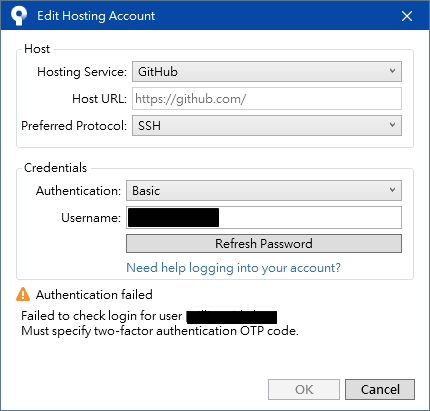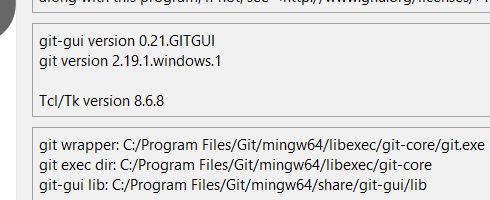- Refreshing Remote Repositories Failed Sourcetree Test
- Refreshing Remote Repositories Failed Sourcetree Download
- Refreshing Remote Repositories Failed Sourcetree Software
Refreshing Remote Repositories Failed Sourcetree For Mac. Refreshing remote repositories failed sourcetree for mac. Maya 2014 With X-force Keygen 2014 Maya 2014 With X-force Keygen. Descargar x force 2014 y 2015, 2016, 2017 x32 y x64 bits. Xforce keygen autodesk. Autodesk maya 2016 crack autodesk maya 2016 crack plus serial. Oct 29, 2019 Why do we need to refresh “ REMOTES ” status in SourceTree? Assuming that all members of your team are working in a repository. One day, a member of your team deleted a remote branch in the repository and other members should get a refresh on their SourceTree’s “REMOTES” to know that, that branch was deleted.
- Sourcetree Refreshing Remote Repositories Failed If you want to access GitLab via SourceTree, you can connect it with an account profile now. Another method is.
- Sometimes, you don't want to clone a repository from the server. This tutorial video will walk you through how to create an entirely local repository.
- Refreshing Remote Repositories Failed Sourcetree For Mac Chandramukhi Serial Actors Real Names Omniweb 4.2 Beta 2 Phoenix For Mac Disable Fast Boot Ithaca Model 51 Featherlight Serial Numbers Mirai Nikki Psp Game English Patch Minion Pro Font Free Mac.
How to fix authentication in Sourcetree with Azure Repos
You will try, and think you are not successful, but you are really near from it ! follow with me:

I am using SourceTree for Windows version 3.2.6
1- Tools -> Options -> Authentication
2- Remove all Visual Studio (or DevOps). Click Ok.
3- Close SouceTree completely. I closed Visual Studio as well, just in case !
3.5 – I switched to DevOps format from Organization settings in DevOps website. So, if you want to follow exactly what I did, do it. Currently it is possible to return back to old format xxx.visualstudio.com. It is your decision !
4- Open SourceTree, go again to Tools -> Options -> Authentication.
5- Enter Host URL as follows: https://dev.azure.com/YourOrgName
6- Prepare your new Personal Access Token, then click “Refresh Personal Access Token” button. Ensure you have this token saved somewhere TEMPORARILY because we will need it.
7- Enter your email as username, and the just generated PAT as password.
It will tell you it failed, do not worry it did not !
8- Click Ok then Close SourceTree Completely.
9- Remove the password cache file called “passwd” in “C:Users{YOUR_USER_NAME}AppDataLocalAtlassianSourceTree”.
10- Open sourcetree again. You can go again to Authentication of SourceTree and see your account has actually been added !
11- Ensure that your repository setting of your git is correctly formatted (https://dev.azure.com/YourOrgName/Project/_git/……)
12- You will notice a new password window shows up asking for password, Enter the same Token which you used it earlier. Note that this password will be cached. You might get the same window when you Fetch anther repository. That is why we saved the token temporarily.
13- Fetch your repos, it should work now. Congratulations !
14- Do not forget to remove the TEMPORARILY saved token (if you saved it somewhere) which can be stolen and used to access your account. I mean that copy-pasted token.
From source: Solved: Azure DevOps with Sourcetree – Adding a remote acc…
A headline feature of SourceTree 1.3 is the support for submodules (in Git) and subrepositories (in Mercurial). The terms may be different, but they refer to the same concept; that of nesting other repositories within the folder structure of your own repository. The most common reason for wanting to do this is that your project has dependencies on other code bases (libraries for example), and you want to track those from their original sources rather than duplicating the files within your own repository.
For the sake of brevity from here on I’ll use the term ‘submodule’ to mean ‘subrepository’ as well, unless I’m talking about a Mercurial-specific feature.
Adding a submodule to your project
Adding a new submodule to your project is simple, just right-click on a blank area of the sidebar and select ‘New Submodule’ (or select it from the Repository menu).
You’ll then be prompted to provide a source URL to clone the contents from, and the path within the current repository that this submodule will reside. Once the submodule has cloned, you’ll see it appear in the sidebar like this:
This tells you that your submodule is located in dependencies/sub1 and is currently on the ‘master’ branch. If you wanted to see more detail about the submodule, just double-click on it to open it in its own repository window, from which you can, if you like, make changes to it just like any other repository. Submodule entries can also have annotations to let you know if there are uncommitted changes in the submodule (ellipsis annotation, i.e. ‘…’), or incoming / outgoing changes (up/down arrow).
In this case you’ve just added the submodule, but it’s not actually committed yet. You’ll see in the file status view that a couple of entries have been staged:
In Mercurial, there will be a “.hgsub” file instead but the principle is the same. These uncommitted changes represent the addition of the submodule to your repository, and you must commit & push them as you would do with any other change. Once you’ve done this, anyone cloning the repository will also get the submodule, at the same commit.
Typical submodule tasks
Submodules are likely to be more static than your own main repository, but there are still several tasks related to them that you may want to do:

Change the submodule commit which your repository is tracking
Submodules are pinned at a given commit, so that you always get the expected version of the submodule contents. If there are new changes in the submodule which you want to use in your repository, all you have to do is open the submodule (double-click) and checkout/update to a different commit, either via pull, merge or just manually checking a commit out – just as you would do normally with any other repository. Once you have done this, return to the parent repository and you will see an uncommitted change on the submodule, which will show in the diff the change in tracked commit:
Refreshing Remote Repositories Failed Sourcetree Test
Again, you commit & push this change just like any other, after which point the submodule contents will be pinned at this new commit.
Commit / push changes to a submodule together with parent repository

If you have write access to the upstream submodule source (and if not, maybe you might fork it and change the submodule source, see below), you may sometimes update files in the submodule, and want to commit / push those changes at the same time as you commit / push changes to your parent repository.
Mercurial actually requires this, by default it automatically commits subrepository changes when you commit the parent, using the same commit message. However, that’s often not what you want – there’s a good chance you’ll want a different commit message for the submodule change. Luckily, SourceTree makes that really easy – when you try to commit the parent, if there are uncommitted changes in submodules you’ll get a prompt telling you so, like this:
From this dialog you can click the ‘Commit’ button next to the submodule and commit those changes with a message of your choosing, separate to the parent repo commit message. In Git, the ‘Skip’ button at the bottom is enabled so you can just leave the changes uncommitted if you like, but Mercurial doesn’t allow this.
Change the source URL for a submodule
Refreshing Remote Repositories Failed Sourcetree Download
A submodule definition includes the URL which people cloning the parent repository will retrieve the submodule content from. Sometimes, you might want to change this – a common example is if you were using a 3rd party library which you had only read-access to, but later decided to fork it and make your own changes. In this case, you’ll want to change the source URL to your fork for all future clones / updates. In SourceTree this is easy, just right-click on the submodule and select “Change Source URL”. You’ll need to commit and push the change as normal, but after that your fork will be the source for the submodule.
Summary
Refreshing Remote Repositories Failed Sourcetree Software
This has been a quick introduction to the submodule and subrepository support in SourceTree 1.3. It’s designed to make your life easier when managing projects with their dependencies and other project groupings, we hope you like it!